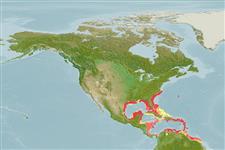Environment: milieu / climate zone / depth range / distribution range
Ecology
Marine; reef-associated; depth range 5 - 91 m (Ref. 9710). Subtropical; 37°N - 4°N, 98°W - 51°W
Western Atlantic: North Carolina to Florida in USA and the entire Gulf of Mexico to Venezuela; possibly to Brazil. The name Equetus acuminatus was misapplied to this species.
Size / Weight / Age
Maturity: Lm ? range ? - ? cm
Max length : 25.0 cm TL male/unsexed; (Ref. 7251); common length : 15.0 cm TL male/unsexed; (Ref. 5217)
Found over soft bottoms (Ref. 9626) of coastal waters. Secretive but approachable (Ref. 9710). Has been reared in captivity (Ref. 35408).
Life cycle and mating behavior
Maturity | Reproduction | Spawning | Eggs | Fecundity | Larvae
Smith-Vaniz, W.F., B.B. Collette and B.E. Luckhurst, 1999. Fishes of Bermuda: history, zoogeography, annotated checklist, and identification keys. American Society of Ichthyologists and Herpetologists Special Publication No. 4. 424 p. (Ref. 35505)
IUCN Red List Status (Ref. 130435: Version 2024-2)
Threat to humans
Harmless
Human uses
Fisheries: minor commercial
Tools
Special reports
Download XML
Internet sources
Estimates based on models
Preferred temperature (Ref.
123201): 23 - 27.9, mean 25.6 °C (based on 322 cells).
Phylogenetic diversity index (Ref.
82804): PD
50 = 0.5078 [Uniqueness, from 0.5 = low to 2.0 = high].
Bayesian length-weight: a=0.00575 (0.00280 - 0.01185), b=3.12 (2.95 - 3.29), in cm total length, based on LWR estimates for this (Sub)family-body shape (Ref.
93245).
Trophic level (Ref.
69278): 3.5 ±0.4 se; based on size and trophs of closest relatives
Resilience (Ref.
120179): High, minimum population doubling time less than 15 months (Preliminary K or Fecundity.).
Fishing Vulnerability (Ref.
59153): Low vulnerability (15 of 100).
Nutrients (Ref.
124155): Calcium = 52.6 [20.1, 107.0] mg/100g; Iron = 0.616 [0.286, 1.222] mg/100g; Protein = 19.8 [18.4, 21.2] %; Omega3 = 0.148 [0.071, 0.278] g/100g; Selenium = 18.6 [8.0, 43.9] μg/100g; VitaminA = 48.5 [11.8, 228.1] μg/100g; Zinc = 0.885 [0.527, 1.448] mg/100g (wet weight);
